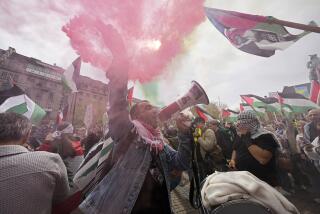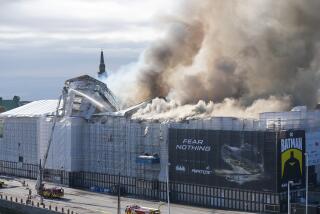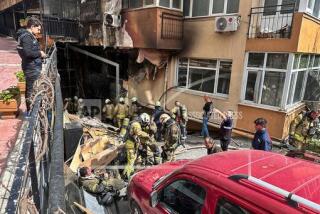Swedish Inferno Raises Fears of Ethnic Hatred
GOTEBORG, Sweden — Numbed shock over the deaths of 60 youths at a Halloween party gave way Friday to fear and revealed hidden ethnic tensions as survivors of the worst fire in modern Swedish history wondered what caused the blaze at an immigrant hangout.
Fire officials in this southwestern port city said they were still investigating whether the fire that flashed through a makeshift disco jammed with as many as 400 teenagers may have been caused by electrical malfunction or arson.
Addressing the mounting suspicion of arson among the city’s non-Nordic residents, Goteborg police spokesman Bengt Staaf said, “We are investigating that possibility, but we have no proof of it.”
Immigrants feared that the Macedonian Assn. community hall may have been targeted by neo-Nazis or ethnic enemies of one of the 20 immigrant groups represented at the party.
“Somebody did this. It wasn’t an accident,” insisted Sokejne Legue, an 18-year-old student of Moroccan descent who was leaving a memorial service for the victims. At least five of her friends were among them.
“Goteborg is so calm. It’s hard to believe anything like this could happen. But the fire couldn’t have spread so fast if it was just an accident,” she said.
Fire and rescue officials who first responded to the call shortly before midnight Thursday also observed in the ghoulish and chaotic first hours after the disaster that the speed with which the blaze consumed the building provoked suspicion.
Some small, fringe neo-Nazi groups have held demonstrations in southern Sweden. But unlike other European countries with large immigrant populations, Sweden is not known to have experienced racially or ethnically motivated attacks.
However, some immigrants here report ethnic tensions below the surface. Nearly 10% of Sweden’s 8.8 million residents are from outside Scandinavia. Goteborg’s industries, including a large Volkswagen plant, have drawn many immigrants.
Nearly one-third of the 173 injured in the inferno were in serious or critical condition from burns and smoke inhalation, and 12 victims had to be flown by helicopter to burn centers in other cities because Goteborg’s hospitals were overwhelmed, rescue service chief Harald Jansson said.
Even if fears of arson prove unjustified, residents complained that enforcement of safety regulations was criminally lax. The private hall had a licensed capacity of fewer than 150.
Authorities were looking into possible negligence by those who rented the hall and allowed the crowd to swell.
“First we have to find out what really happened there and if there are any possible criminal cases against anybody. A charge could involve manslaughter,” prosecutor Ulf Noren said.
The second-floor Macedonian Assn. hall above an appliance store in an old brick structure had been rented for the night to a couple of young men who organized a Halloween dance during this week’s autumn school break, police spokesman Staaf said.
More than half of those at the disco were from former Yugoslav republics. Some mourners expressed fears that the ethnic hatreds fueled by the bloody conflicts in the Balkans may have entered Sweden along with the refugees.
“Some people still hate each other, even though they came here to escape the hatred,” said Goran Zor, a recently unemployed 35-year-old who came with his parents to Sweden from Macedonia more than 30 years ago. “I hope [the fire] was not an attack, but it was so huge. I don’t know how it could just start by itself and move so quickly.”
Jenni Dolgren, 16, managed to escape a crush of panicked youths trying to flee the hall through the only unobstructed door. A second exit reportedly was blocked by sound equipment.
“I was trapped at the door. Everyone was pushing, so no one could move,” Dolgren recalled as she arrived for the memorial service at the Dome cathedral, swollen-eyed and supported by two girlfriends who came to mourn fellow revelers.
Many of the 59 bodies pulled from the charred wreckage were found piled on top of each other inside the door where the youths collapsed from suffocation, blocking the escape of others behind them, said Hans Carlsson, who is leading the police investigation. One victim rescued from the fire died later in a hospital.
The memorial service, attended by a stunned and tearful Prime Minister Goran Persson, drew at least 1,500 people, mostly youths with body-piercings and bloodshot eyes who lost friends and relatives.
Persson had laid flowers at the gutted community hall earlier in the day and was visibly shaken. “It was all burned out, with only a skeleton left. On the floor there were shoes and boots--boots just like our own children have. It was only then that you could really understand what happened.”
Only 14 of the 60 confirmed dead had been identified by late Friday because the bodies were badly burned, and parents had to spend the day scrambling from one hospital to another to inquire about their missing children.
“Nothing like this has ever happened in Goteborg. It’s such a quiet place,” said Lars Pohlsson, whose taxi company ordered drivers to aid the victims in any way they could. “I’ve been driving people around all day to hospitals and police stations, and they are all just in a complete state of shock.”
Another driver who was called in to help expressed less surprise than his Nordic colleagues. The Tunisian-born driver, who refused to be identified, said Swedish resentment of immigrants seethes below a calm surface.
He recalled that a fire broke out a few years ago in the school his daughter attends, and he and other parents had rushed to help with the evacuation.
“I was told not to interfere,” he recalled with bitterness. “This fireman told me, ‘You’ve taken enough of our jobs already.’ ”
Out of respect for the victims, city officials called on cinemas and theaters to shut down for the night Friday. Sporting events were canceled across Sweden, and flags on all official buildings were lowered to half-staff.
More to Read
Sign up for Essential California
The most important California stories and recommendations in your inbox every morning.
You may occasionally receive promotional content from the Los Angeles Times.











